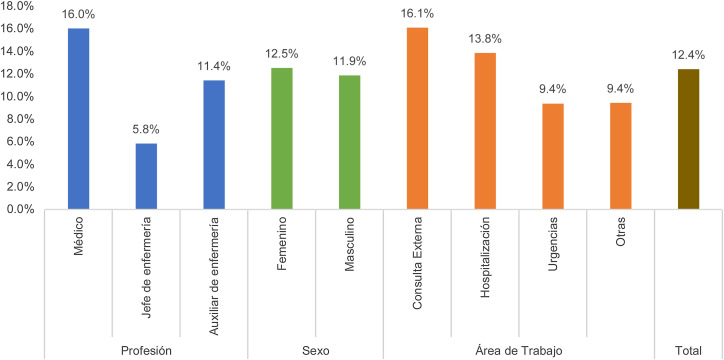Síntomas depresivos en trabajadores de la salud dos años después del inicio de la pandemia COVID-19 en Bogotá, Colombia
Q3 Medicine
引用次数: 0
Abstract
Introduction
During the COVID-19 pandemic, different events arose worldwide, including the impact on the mental health of health personnel. Our main aim was to determine the association between sociodemographic, clinical, tobacco and alcohol abuse, and fear of COVID-19 variables with the presence of depressive symptoms in a healthcare facility, in Bogotá DC, in 2022.
Materials and methods
Analytical cross-sectional study. Sociodemographic and clinical variables, alcohol and tobacco abuse, and fear of COVID-19 were explored. The presence and severity of depressive symptoms were evaluated with the PHQ-9 scale. Descriptive analysis and chi-square tests were performed. Statistically significant variables (P < .05) were entered into a logistic regression model with depressive symptoms as the dependent variable.
Results
597 people were included, 80% female. The median age was 34 years (Interquartile Range [IQR]: 28-41. The prevalence of depressive symptoms was 12.4% (95% CI: 9,74-15,05). The multivariate analysis showed that fear of COVID-19, tobacco use, age under 28, and middle socioeconomic status were the factors that best explained the presence of depressive symptoms.
Conclusions
Two years after COVID-19 was declared a pandemic, the prevalence of depressive symptoms is 12.4%. It is necessary to carry out strategies to promote mental health in health professionals.

哥伦比亚波哥大2019年新冠疫情爆发两年后卫生工作者的抑郁症状
在2019冠状病毒病大流行期间,世界各地发生了不同的事件,包括对卫生人员心理健康的影响。我们的主要目的是确定2022年波哥大特区一家医疗机构中社会人口学、临床、烟草和酒精滥用以及对COVID-19变量的恐惧与抑郁症状之间的关系。材料与方法:分析性横断面研究。研究探讨了社会人口统计学和临床变量、酒精和烟草滥用以及对COVID-19的恐惧。用PHQ-9量表评估抑郁症状的存在和严重程度。进行描述性分析和卡方检验。统计显著变量(P <;0.05)以抑郁症状为因变量进入logistic回归模型。结果共纳入597例,其中女性占80%。年龄中位数为34岁(四分位间距[IQR]: 28-41岁)。抑郁症状的患病率为12.4% (95% CI: 9,74-15,05)。多变量分析显示,对COVID-19的恐惧、吸烟、年龄在28岁以下和中等社会经济地位是最能解释抑郁症状存在的因素。结论新冠肺炎大流行后2年,抑郁症状患病率为12.4%。有必要实施促进卫生专业人员心理健康的战略。
本文章由计算机程序翻译,如有差异,请以英文原文为准。
求助全文
约1分钟内获得全文
求助全文
来源期刊

Revista Colombiana de Psiquiatria
Medicine-Psychiatry and Mental Health
CiteScore
2.50
自引率
0.00%
发文量
72
期刊介绍:
Revista Colombiana de Psiquiatría (RCP) is a quarterly official publication of Colombian Psychiatry Association (March, June, September and December) and its purpose is to spread different the knowledge models that currently constitute the theoretical and practical body of our specialty. Psychiatrists, psychiatric residents, non psychiatric physicians, psychologists, philosophers or other health professionals or persons interested in this area can take part in the magazine. This journal publishes original works, revision or updating articles, case reports of all psychiatry and mental health areas, epistemology, mind philosophy, bioethics and also articles about methodology of investigation and critical reading.
 求助内容:
求助内容: 应助结果提醒方式:
应助结果提醒方式:


